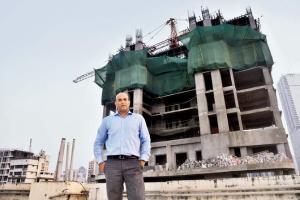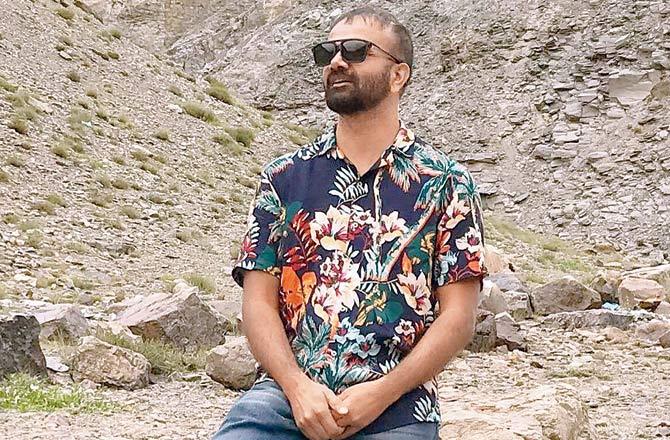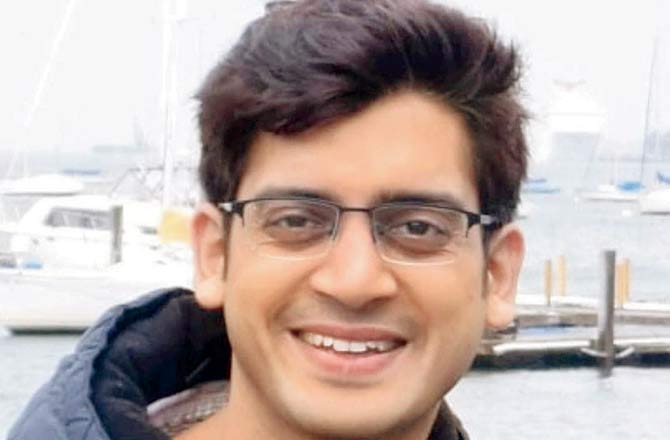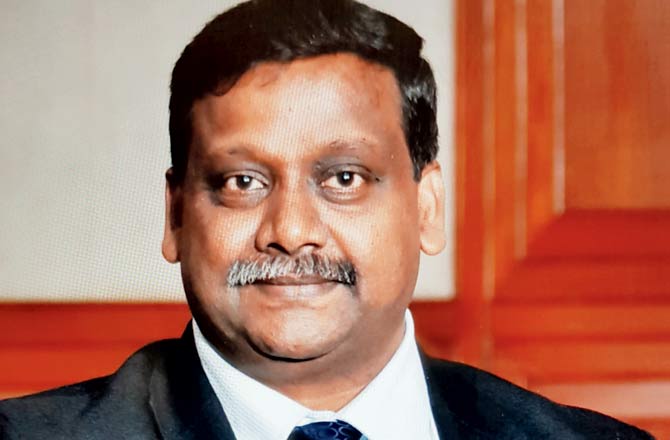Rising pollution levels in the political and financial capitals of the country are making people, especially young parents quit jobs and leave home. But where do you go when you've lived in the metro all your life?

Worli resident Pavan Lall, 43, says rampant construction, the resultant pollution and monsoon flooding made him consider leaving Mumbai. Pic/Pradeep Dhivar
Air pollution in Delhi is such a trending topic, that it has its own Twitter handle. That, for a change perhaps, politicians are being pulled up for not attending critical meetings on an issue of national importance. You want to laugh when Sameer Sewak, 29, says, "We don't see blue skies in Delhi. On the few occasions it happens, people bring out their phones to take pictures."
But you don't. Because Sewak ends the thought with, "it's not worth it." The country's capital has been at the centre of a raging conversation about pollution since Diwali this year after its Air Quality Index (AQI) touched 999 in some areas (reading beyond that is not possible). The 'Okay' limit is 60. By comparison, post-Diwali Mumbai saw an AQI of 80.

The Gurugram and Mumbai sklylines engulfed in smog at different points this year. Pic/Getty Images
While Delhi has seen a ban on fire crackers for a couple of years, the toxic air levels saw a temporary ban on construction activity—with a few arrests being made after some real estate firms were found to have flouted the rule—and the re-implementation of Chief Minister Arvind Kejriwal's odd-even scheme. That too has now been called off, as the air quality seems to have improved. But, certain factors continue to bring Delhi down. Winter and with it, the smoke from stubble burning in farms in Punjab, Haryana and
Uttar Pradesh.
"The throat hurts, the eyes hurt. You feel tired a lot more. And knowing how much it [the pollution] affects your health, reducing your life, heart and lung functioning capacity, it doesn't make sense to live in Delhi." Sewak no longer does. A commercial pilot trained in Canada and currently giving exams to convert the license to an Indian one, Sewak and his family moved out of Delhi in May this year, after his father Regginald made the suggestion.

"A banker, his job had taken him around the country. He had lived in Dehradun before we moved to Delhi," says Sewak, whose sister, a student at St Stephen's college, stays at a paying-guest accommodation to continue with her education.
It wasn't difficult for the Sewaks, who lived in the Civil Lines area of New Delhi to pack their bags and move out. Regginald got a transfer within two months of applying for it. His wife Swapna, a teacher at Modern School in Shalimar Bagh, is currently looking for a new job. On his part, Sewak doesn't need to be in Delhi very often. When he does, it's a short flight away.
But, the Kalras of Noida had to wait a while for the right job opportunity to come along. Kalpana, 37, lived in Delhi for 25 years before moving to Bengaluru three years ago. It was a shift necessitated after their daughter Mishka's health began deteriorating due to the particulate matter in the air. "Around the time she was four, Mishka developed a cough after attending a birthday party," says Kalpana, a homemaker. So clearly etched is the memory that she remembers the party was in April.

Sanjay Austa, journalist Moved from Delhi to Himachal Pradesh
"Initially, Rajiv [her husband] and I thought it was a regular cough, but when it didn't go away, we had to consult a doctor." Mishka was admitted to hospital and given an oxygen mask. The parents were told that their daughter's breathing pipe was not well developed and she had got an allergy because of the pollution. "The doctor said that this would continue to happen till she reaches an age where her organs are developed. So, for the two years till we moved out, she'd often have acute bronchitis attacks and was once in the ICU for four days. All because of the pollution and dust from construction in Delhi."
Having grown up in the city, Kalra says Delhi's change has been upside down. "The environment was bearable and one could move freely. Today, most children use a nebuliser. You can't drive with the window down. If we had continued living in Delhi, Abhimanyu [son] would have gone down the same path."

Kalpana, Rajiv, Mishka and Abhimanyu Kalra moved from Delhi to Electronic City on the outskirts of Bengaluru. Pic/Ajeesh F Rawther
For young parents, concerns are many. Rajiv, who then worked with Alstom, a French MNC, took a year before he found a job with a US-based company that allowed him to move to Bengaluru. The kids had to be moved out of their schools, and entered into new ones at Electronic City on the outskirts of Bengaluru. Because of the initial admission fees and donations, it was an expensive affair. "It took us three months to figure out the logistics. When my husband first arrived [to Bengaluru], we were in Delhi. It was a slow transition as the academic session had to be completed before moving to a new place."
It's the same considerations that are making Mumbai-based journalist and author Pavan Lall look for other cities to work in. The 43-year-old says that the last one year has been unusually difficult due to traffic, sound and air pollution. "This was not the case five years ago, before the Metro construction began." He recalls how in 2018, during the monsoon, the city was dug up and Worli, where he lives, suffered especially on days of heavy downpour. Thanks to the road being excavated for the Metro.

Sameer Sewak, Pilot, Moved from Civil Lines in Delhi to Dehradun with his parents Regginald and Swapna
"When you have a white collar job, there's limited fresh air circulation available to you anyway. The powers that be need to introspect about what they are offering citizens who work hard. There should be laws to ensure basics like fresh air, and peace and quiet at night," says Lall. The challenge of course, is where does one go. Delhi has been ruled out. Bengaluru, too, has manic traffic. There are a few southern cities that are better, he says, but that decision is pending the family's and employer's final approval.
Where do you go when you have lived in a metro city? For the Kalras with two kids in tow, Bengaluru remained a good choice, yet not an easy one. Rajiv's parents, who are both older than 80, live in Haridwar. Visiting them has been difficult. The family's own social network had to get adapted to this state. And of course, the fact that Bengaluru comes with its own share of problems. "There are security issues. I had to check with the school [the kids are admitted at] about bus drivers and police verification, which is still at a nascent stage here compared to Delhi. Plus, the city gives you a pollen allergy for three to four months in the year. But, I think this is manageable when compared to what we faced in Delhi. In the time we have been here, Mishka hasn't had a single attack."
Besides, a post metro life can have other perks. Journalist Sanjay Austa, lived in Delhi since the 1990s, but is pahadi and studied at a school in Shimla. Like most immigrants, he lived around the city, but never took to it. "I created an option of a farmhouse in Himachal and was able to move there." While pollution wasn't the primary factor that drove him away from Delhi, it's certainly a reason that makes him think twice about returning. Even if for an annual trip. "I don't want to go in the winters, since I don't want to wear a mask. I like jogging and cycling but you can't do that in Delhi. Inside the house as well, levels of particulate matter have shot up."
Austa, who made the permanent move two years ago, is single. He says those who can set up life away from the big cities, should, as responsible citizens. Comparing life in the hills with that in Delhi, he says, "Yes, you can't watch cinema or go to a restaurant to eat. But one is well compensated. With Netflix, who is going to the theatre anyway? Instead of a restaurant, I can go to a forest. People are paying me to come and live here." He doesn't say it, but what more could you want?
10,000
Litres of clean air needed every day to nourish the body with oxygen
6.5m
Number of premature deaths globally linked to household and ambient air pollution in 2016, as per WHO
999
Delhi's Air Quality Index (AQI) score early November against an Okay limit of 60
Particulate matter explained
Particulate matter refers to tiny bits of solids or liquid suspended in the air. They range from bigger particles such as soot or dust to particles which are smaller than the width of human hair. The tiny ones are most dangerous for health since they can penetrate deep into the lungs, and potentially even into the bloodstream and brain. For babies and young children, the health effects are even more acute. Exposure to toxic particulates during the critical early stages of development can leave a child with stunted lungs, respiratory conditions like asthma and potentially, even reduced brain development.
- UNICEF October 2018 report
Twitter tackles pollution
Rishabh Jain, Supreme Court lawyer and Delhi resident
Runs @Delhi_Pollution since
April 2016
We first started observing pollution in Delhi in the early 2000s, when you thought that soot would settle on your shirt. In 2013-14, it became a grave issue. Every winter, there were days when flights couldn't land, because of what appeared to be fog. As information started coming in, you realised that it was actually pollution and not fog. Even today, there are only a handful of people who are active about the issue. The common man doesn't wear a mask or have an air purifier and lives as though nothing has changed. Even though we are in an air pollution emergency.

Rishabh Jain
The idea of setting up the handle came in April 2016. We realised that everyone talks about it in October-November, after that there is silence. That's when we started tweeting about the issue, the reports that came out. Some political shaming, not about one party, but across the board. There has been some frustration, too. While we have got some people on board, we are disenchanted by the overall approach of the political class.
Our conversations are limited to Twitter, but more recently, other activists have taken this up on other platforms, too. And we ensure that their message is amplified. If someone calls for a march, we give a shoutout. But there's the issue of creating awareness. Our own families believed for a long time that as you breathe in polluted air, your immunity becomes stronger and eventually Delhiites will have better lungs than the rest of India. It took us a long time to convince them otherwise. If you talk to the average citizen in Delhi, that's the approach. They see it as a seasonal phenomena. Largely, it's those with kids who want to move out. Adults never do it for themselves. I know of a lot of firms who are giving out masks and air purifiers as a coping mechanism to their employees.
In terms of policy, India has a well defined National Clean Air Programme (NCAP) with the aim of 30 per cent reduction of PM2.5 and PM10 concentration by 2024. It requires investment, which somehow seems to be absent. The problem is not restricted to Delhi, however. It's the entire Indo-Gangetic plain. Why Delhi gets attention is probably because it's the mega city. But, it's as bad in Punjab and West Bengal. While stubble burning and industrial emission contribute to 40 per cent of the problem, there are other factors, like vehicular pollution. Is the state or national government taking policy decisions to address these factors? The electric vehicle industry needs an incentive from the government. Have they pushed for car pooling? They haven't. The subsidy they provide for electric vehicles is very low.
Imagine that at a time when the auto industry needs a boost, they could push for electric vehicles and address two issues at the same time. They need to provide enough incentive. Then, they need to build the network of charging centres, and provide better infrastructure. My reading of the situation is that because air pollution doesn't kill you immediately, it doesn't require urgent attention. It's very easy for the political class to shrug off responsibility. It's the citizen who suffers. The political class can have as many air purifiers as they want.
Pollution affects heart, brain
While the deterioration of air quality is directly linked to respiratory complaints, interventional cardiologist Dr Ajit Menon, who consults at various city hospitals, says that particulate matter could affect cardiac health. He explains severe respiratory infections are related to heart disorder. "We see an increase in respiratory ailments and associated cardiac ailments especially during winter. Any time that the air quality deteriorates, there is an increase in number of respiratory ailments. As a consequence, patients with compromised heart pumping and pre-existing cardiac ailments are left worse off." Apart from vehicular fumes and dust from construction activity, Dr Menon says that poor air circulation also contributes to pollution. "During winters, wind patterns change and pollution in the air doesn't blow into the sea, which then starts choking the city."

Dr Sundeep Salvi
Dr Sundeep Salvi, director, Chest Research Foundation in Pune, says we need to breathe 10,000 litres of clean air each day to nourish the body with oxygen. The inner lining of the lungs comes into contact with a lot of pollutants, gaseous or particulate. The harmful effects of air pollution can cause asthma, bronchitis, pneumonia while long term exposure can cause lung cancer and Chronic Obstructive Pulmonary Disease too," he shares.
Given the reference point of fine particulate matter (PM 2.5), which is used to measure the extent of air pollution, Dr Salvi says that in a city like Mumbai, the PM 2.5 level is 150-200 micro grams per cubic metre while for Delhi, the pollution levels are at about 600-800 micrograms per cubic metre. "The safe limit prescribed by the World Health Organisation is less than 50. Mumbai is lucky because it has the Arabian Sea winds to wash away the pollution."
With these figures, Dr Salvi paints a grim picture. "Air pollution inhaled through the lungs enters the blood stream and affects the heart, brain and other organs. It has the potential to reach and damage every tissue in the body. Blood becomes thick and there are chances of developing clots, leaving you susceptible to stroke. It also increases risk of diabetes," he says. Unfortunately, not much is being done to tackle this problem.
Inputs by Arita Sarkar
Catch up on all the latest Crime, National, International and Hatke news here. Also download the new mid-day Android and iOS apps to get latest updates
 Subscribe today by clicking the link and stay updated with the latest news!" Click here!
Subscribe today by clicking the link and stay updated with the latest news!" Click here!









